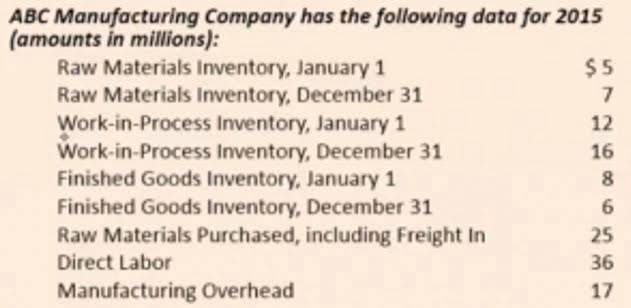
Time cost forms a significant portion of indirect costs, hence critical for running the business. The financial advisor advises them to take a loan from a recognized financial institution as they would charge a lower interest rate. It was estimated that a rate of 10% would be required to pay $5.4 million annually (simple interest rule) and which they could capitalize on in the initial year.
- Ever wondered how businesses track and manage the various expenses they incur while keeping their operations running smoothly?
- Product Costs are essential for calculating the cost of goods sold and determining the gross profit margin of a business.
- However, the cost, which will be an expense in the future, will be recognized as a period expense.
- Additionally, it allows for the preparation of financial statements that accurately reflect the financial performance of the company.
Period Costs vs. Product Costs
In FIFO costing, the costs in the beginning inventory are transferred out in a lump sum. FIFO costing does not mix costs from prior tenure (in beginning inventory) with a current period expense. A Insurance Accounting period cost can be termed as any cost that cannot be categorized into prepaid expenses, fixed assets, or inventory. Rather than being a transactional event, this cost is more closely linked with time.

Products

The main product of Google is to act as a search engine, and no doubt, employees are the main head behind that. Still, the travel and entertainment are not directly related to the product cost, and since they are incurred periodically, they must be assigned as a periodic expense. Period costs are not incurred directly with the period costs product or are not directly responsible for product manufacturing.
- By accurately reporting and analyzing these costs, businesses can gain valuable insights, make informed decisions, and drive sustainable growth in today’s competitive business landscape.
- These expenses are deducted from revenues to calculate operating income, reflecting the costs incurred to support the business’s ongoing operations.
- Generally, fixed cost consists of fixed production overhead and Administration Overhead.
- There is no fixed approach to identifying the period expense in all the particulars.
- The firm will not incur enabling costs if operations shut down but will incur them if operations occur.
- Period costs provide essential and useful information about a company’s operational efficiency.
Revenue Generation (What It Means And How It Works: Overview)
- Effective management of period costs can lead to greater profit margins and overall business success.
- Overhead costs are costs incurred in the manufacturing process while period costs are not tied to the production process.
- Examples of period costs include general and administrative expenses such as office salaries, advertising expenses, rent, office supplies, and utilities that are not part of manufacturing.
- However, managing Period Costs effectively indirectly impacts the balance sheet by influencing cash flow, liquidity, and profitability.
- Period costs can be separated by category on the income statement to help understand what the costs are and how much is spent on each.
- Direct allocation provides a simple and transparent way to assign costs to cost objects, making it easier to trace expenses and calculate the true cost of producing goods or services.
Period costs or period expenses are specific type of expenses a company may incur during an accounting period without being able to link it to inventory or cost of goods sold. Also termed as period expenses, time costs, capacity costs, etc these are apportioned as expenses against the revenue for the given tenure. Some examples include General administration costs, sales clerk salary, depreciation of office facilities, etc. ABC provides a more accurate understanding of cost behavior and cost drivers, enabling businesses to make more informed decisions about pricing, product mix, and process improvement.
Indirect Allocation
Indirect allocation requires careful consideration of allocation bases to ensure that costs are allocated fairly and accurately. Common methods of indirect allocation include the use of predetermined overhead rates or activity-based costing (ABC) systems. Direct allocation provides a simple and transparent way to assign costs to cost objects, making it easier to trace expenses and calculate the true cost of producing goods or services.

Since product costs are linked to a product, a company can report such costs in the category of cost of goods sold on the income statement. Since that cost is included in the fixed asset, which occurs just once, it would not be considered a period cost. However, the cost, which will be an expense in the future, will be recognized as a period expense.
Variable period costs can be more challenging to predict and manage than fixed costs since they are directly tied to production levels. Effective inventory management and production planning can help mitigate the impact of variable costs on profitability. However, managing Period Costs effectively indirectly impacts the balance sheet by influencing cash flow, liquidity, and profitability.

Items That are Not Period Costs
Additionally, it allows for the preparation of financial statements that accurately reflect the financial performance of the company. The accounting treatment of period costs involves recognizing and recording these expenses in the period in which they are incurred. Unlike product costs, which are initially recorded as assets and then expensed when the products are sold, period costs are expensed immediately. Period costs are necessary for the day-to-day operations of a business and are essential for running the company smoothly.
Understand how these costs are different from product costs and their impact on financial statements. The period cost is important and a necessary thing to keep track bookkeeping of because it allows you to know your company’s net income for each accounting period. Keeping track of the period of cost is also important for filing accurate business taxes and for preparing for an audit.